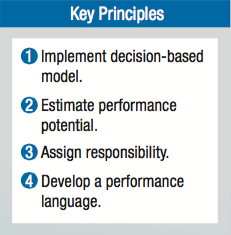Aligning Personnel to Achieve Corporate Objectives
Problem: Communicating Corporate Objectives
In today’s hyper-competitive business climate, C-level executives want to leverage their most valuable resource—people. People are the key to staying competitive advantage in today’s global market.
Products can be quickly duplicated and services cheaply emulated, but people provide the innovation, execution, and knowledge to drive your organization for- ward. This collective talent is your primary resource for effectively competing and winning—if you can leverage it as part of a process of strategic planning.
A recent survey by Bersin and Associates reported that 60 percent of executives felt the challenge of aligning employee capabilities with company business strategy.
New technology has the potential to streamline strategic talent management processes and empower you to achieve maximum employee productivity and performance. What is troubling, however, is that despite having these tools, only a small percentage of executives have implemented performance management programs and effectively aligned their workforce with their company objectives.
Moreover, a recent McKinsey & Co study of human resource professionals revealed that 72 percent of respondents were dissatisfied with the current performance review process at their company.
Along with problems aligning employee development with organizational goals and objectives, many companies have difficulty tracking employee and department progress against company goals and targets. Many companies have difficulty providing employees with a fundamental understanding of corporate goals.
Solution: Effective Strategic Planning
Strategic planning offers an effective strategy for addressing this problem. It ensures that all employees understand your main objectives and remain motivated and focused on productivity and customer service.
But a strategic planning needs accurate data and measurement-driven processes to be successful. Data and processes yield best practices, industry insights, and innovative strategies. They enable you to focus organizational attention on the most important issues and create the greatest performance leverage.
There are four key principles of strategic planning that ensure your data and measurement-driven processes are aligned with your performance-management objectives for employees.
Principle 1: Implement a decision-based model of performance. Develop a decision- based model of controllable performance and apply it throughout your organization. The model is comprised of factors that drive decisions. The components of the model are operational and address the managerial disciplines from which management make decisions. These include such issues as customer acquisition and retention, productivity, efficiency, and risk control.
Principle2: Estimate performance potential. Answer the question, “How well should we be able to perform?” And answer it for each individual and departmental metric measured. Companies routinely compare actual performance to planned performance objectives to assess the accomplishments of individuals and make decisions about compensation and advancement. But comparing planned and actual performance objectives has little value for determining where the application of effort can produce the best returns. This requires an understanding of how well individuals and units are doing in comparison to how well they ought to be able to perform.
Principle 3: Assign responsibility for controllable aspects. Hold decision makers accountable for the performance metrics they control. The overall effectiveness of any performance management process depends on accountability. Accountability ensures that your people focus on the right issues and strive to achieve the right targets. Equally important, decision makers must be allowed to recognize opportunities, improve performance, and identify those responsible for capturing each of these opportunities.
Principle 4: Develop a common performance language. Develop a common performance language that connects operational performance and individual responsibilities to corporate performance objectives. This is essential to ensure organization alignment and cohesive decision-making. Well-aligned organizations need a performance language that ensures a shared understanding of how all disciplines must work in combination to create organizational success. This language must relate decisions made about operational factors to corporate performance objectives.
(References: Performance Management 2006. Comprehensive Industry Study: Market Analysis, Trends, Best Practices, and Vendor Profiles. Josh Bersin, Principal Analyst, June 2006 Page 166.
RESEARCH HIGHLIGHTS How the Top 20 Companies Grow Great Leaders. Hewitt & Associates: Talent and Organization Consulting Practice, Marc Effron, Michelle Salob, & Shelli Greenslade. 2005
Bernthal, P., Sumlin, R., Davis, P., & Rogers, R. (1997). Performance Management PracticesSurvey Report. Development Dimensions International.
The Wyatt Company. (1994). The 1994 Wyatt Performance Management Survey. The WyattCompany)
